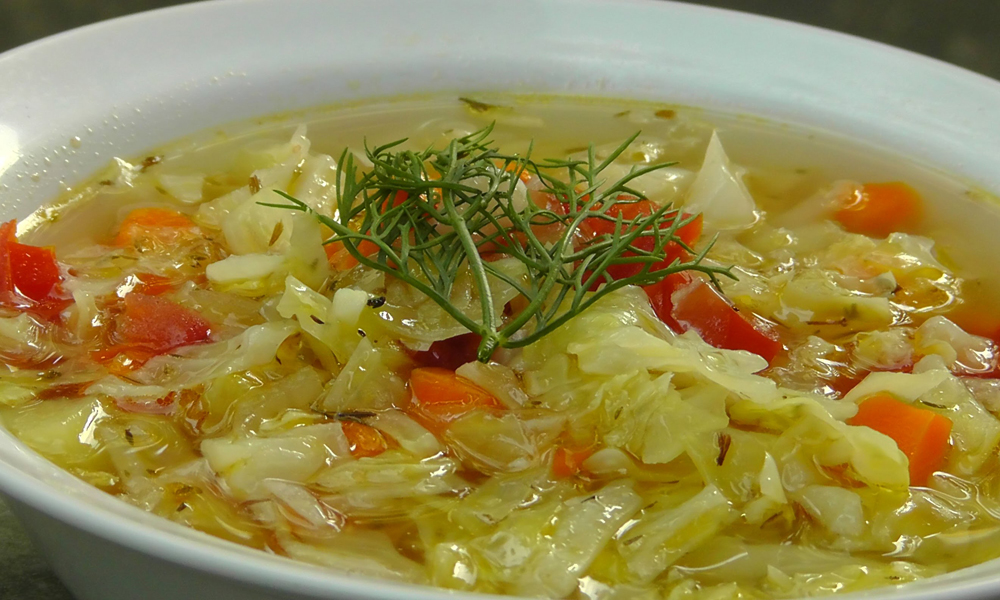Have you ever wondered what is the Cabbage Soup Diet? It’s may appear to be an easy answer, but it’s not. There are as many variations of this weight-loss recipe as there are people who make the soup for it, adjusting it to their own tastes, and then publishing the recipes for it all around the internet under the name “Cabbage Soup Diet”. Since it was never a trademarked name or diet, this makes it all the more difficult to track down the real and original version of this ageless and popular diet.
So, just what is all the fuss about with this diet soup?
The cabbage soup diet turned up sometime in the 1980’s and is generally considered to be a fad weight loss diet. Its radical fat-loss method is designed around heavy consumption of a low-calorie soup over the span of seven days. It is designed for short-term weight-loss only. Since it requires no long-term commitment to a lifestyle change, or to any exercise, and is devoid of many nutrients, including a lack of protein for several days in a row, it is not recommended by nutritionists. However, because of its ability to cause rapid weight loss, several copy-cat diets have been created that are based on the similar principles of extremely low calories and eating as much as you want of only one food. All of them claim success in someone, but none of them are nutritionally sound.
Its main claim to fame, as it were, is that you can to lose 10 pounds (4.5 kg) in a single week. However, experts have pointed out that it is physiologically impossible for the body to burn that much fat within a single week, and certainly not just by eating soup and not exercising. It is therefore more likely that the weight lost is mostly water-weight as well as some muscle tissue, due to the lack of protein.
But if you insist on going on the cabbage soup diet anyway, the one presented here has been stated to be the original one that was published in the National Enquirer tabloid around 1995-1996 at the height of the cabbage soup diet fad.
The Original Cabbage Soup Diet
Preparation Time: 10 minutes
Cooking Time: 1 hour
Yield: 20 servings
- 1 head cabbage, chopped
- 6 onions, sliced or chopped
- 2 green bell peppers, chopped
- 1 bunch celery, chopped
- 1 bunch shallots or 1 bunch green onion, sliced
- 2 chicken bouillon cubes
- 1 (1 1/4 ounce) envelope onion soup
- 1/2 cup balsamic vinegar (optional)
- 48 ounces V8 vegetable juice
- 2 (28 ounce) cans chopped tomatoes
- juice of 1 lemon
- black pepper, to taste
- 6 garlic cloves, crushed
Directions:
1. Place all ingredients into a large stock pot
2. Bring to a boil
3. Simmer for 1 hour
4. Enjoy your first bowl
5. Refrigerate the leftover soup
6. Reheat as needed, but not in the microwave as this will destroy many of the nutrients
The nutritional breakdown for the “The Original Cabbage Soup Diet” above is as follows:
- Serving Size: 1 (281 g) or approximately 8 oz
- Calories: 67.5
- Calories from Fat: 4
- Total Fat: 0.4 g
- Saturated Fat: 0.1 g
- Cholesterol: 0.0 mg
- Sodium: 277.4 mg
- Total Carbohydrates: 15.1 g
- Dietary Fiber: 3.8 g
- Sugars: 8.1 g
- Protein: 2.7 g
Now here is where things get dicey. Note that the calorie count will change depending on which cabbage soup diet recipe you use, but the soup is generally meant to be very low calorie. The type of cabbage mentioned in the recipe is not specified. There are many types of cabbage heads and each has a wide variance of calories.
Additionally, the nutrients in the different cabbages not only vary, but many of them are destroyed by boiling, which makes this soup even less than optimum healthy choice for a week-long regime. Make sure you take a multiple vitamin at the very least!
OK, you’ve made the soup, now what?
Here is what is allowed when following the cabbage soup diet:
The only beverage that is allowed is plain water. Occasionally unsweetened fruit juice can be consumed, but only on those days when fruit is allowed. The daily menu below is even more rigid, with the exception of the soup itself.
- Day 1 – As much cabbage soup as you want plus as much fruit as desired (no bananas)
- Day 2 – As much cabbage soup as you want plus vegetables including 1 baked potato (including the skin) with a little butter
- Day 3 – As much cabbage soup as you want plus fruit and vegetables (no potatoes or bananas)
- Day 4 – As much cabbage soup as you want plus up to eight bananas and as much skim milk as desired
- Day 5 – As much cabbage soup as you want plus up to 10 ounces (280 g) of beef and up to six tomatoes
- Day 6 – C As much cabbage soup as you want plus as much beef and vegetables (no potatoes) as desired
- Day 7 – As much cabbage soup as you want plus brown rice, vegetables (no potatoes) and unsweetened fruit juice
To re-iterate, according to medical professionals, most of the weight loss from the cabbage soup diet is actually a water loss and not a fat loss. This means the weight will come back quickly and that the loss is not permanent. This diet is really only useful for when you need to lose a lot of weight fast to fit into a dress or suit due to an upcoming event, such as a wedding.
Another concern is that the number of calories per day is far lower than the required intake that is considered to be safe for the body in terms of just general maintenance and body functioning. Even if you ate ten 68-calorie servings, you would only get 680 calories. You may be able to add a few hundred more calories from the other foods on the days you can eat them, but it will still be hard to bring up your daily caloric levels to where they need to be. This recommended minimum intake is different for different people, but in general, for women it is at least 1,200 calories per day, while men should eat at least 1,800 calories per day.
Extreme restriction of calories under that 1200/1800 calorie level can significantly slow the metabolic rate, and hinder any future weight loss goals for potentially up to a year.
This metabolic slow-down is part of a chain reaction of physiologic responses that trigger the breakdown of muscle (which is needed for fat burning) in order to supply the body with enough fuel (in the form of glucose) to maintain proper blood sugar levels in the absence of sufficient dietary intake calories. This is known as the “fight or flight” stress response and it will eventually wear itself out and slow down the metabolism to compensate for what the body perceives as starvation.
Some studies have indicated that a long-term diet that uses calorie restriction can lower your metabolism by up to 40 %. It has also been noted that it can take up to a full year to correct a sluggish metabolism, during which time, you gain back what you lost, plus more, to help compensate for not having “enough” fat stores during the “famine”, which happened to be your diet.
This is why the cabbage soup diet should not be used for longer than 7 days.
The cabbage soup diet also provides a near zero protein amount for four straight days. Many people report feeling weak, lethargic and light-headed while following the diet. They have no energy for exercise even if they wanted to. Protein deficiency is nothing to fool around with as it can lead to gallstones, arthritis, muscle deterioration, as well as heart problems. The treatment for a protein deficiency is easy, but the lack of protein must first be properly diagnosed by your doctor. If you suspect that you may have a protein deficiency, don’t wait to seek help.
If you decide to create your own version of the soup, be careful what you add as you may defeat the purpose of eating the soup to begin with. For example, adding carrots or even substituting them for another ingredient adds a lot of sugar. If you want to add flavor to what many people criticize as a bland soup, then add fresh herbs to make it a bit more spicy.
Many people also criticize the amount of sodium vs the apparent lack of a balancing amount of potassium in the soup because of the bouillon cubes. Without knowing if the cubes are being used for some special ingredient they may have, it is hard to recommend that they be eliminated altogether. However, there are a couple of ways around this sodium issue. If the bouillon cubes have no special reason for being in the soup, then one way would be to substitute actual unsalted chicken broth and salt to taste. Another method would be to peel a potato and put it in the pot whole, while the soup is cooking, and then remove it and throw it out when the soup tastes less salty or closer to how you would prefer it. Potatoes are well known for absorbing salt when cooks, or their assistants, accidentally put too much in.
One of the problems with being forced to eat a bland soup is that few are able to actually stick to the diet for the entire seven days. Additionally, many dieters report feeling nauseous whenever they smell the soup near the last days of the diet.
Cabbage also has a bit of an anti-social trait that is well-documented, though it is one that most often comes to mind when thinking about beans. Yes, flatulence is a common side effect of the diet.












